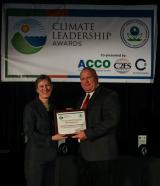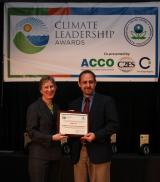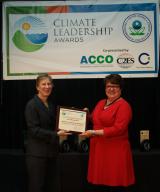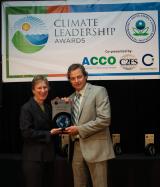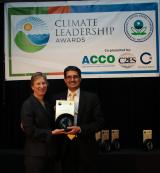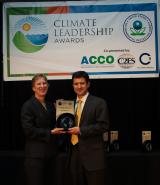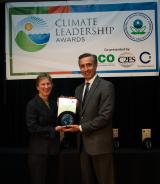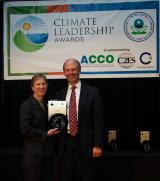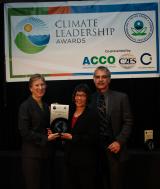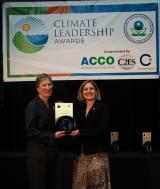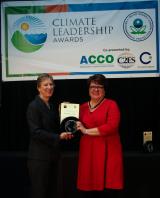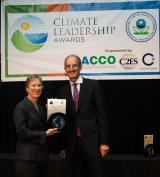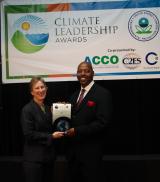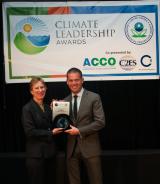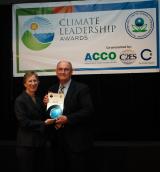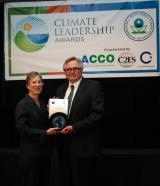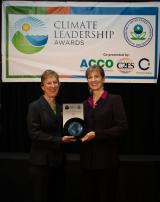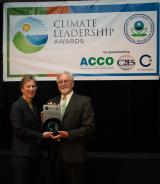2014 Climate Leadership Award Winners
 Congratulations to the 2014 Climate Leadership Award winners! Two Individuals and 15 Organizations were publicly recognized for their leadership in reducing greenhouse gas emissions during the awards dinner on February 25, as part of the Climate Leadership Conference, held in San Diego from February 24 - 26, 2014.
Congratulations to the 2014 Climate Leadership Award winners! Two Individuals and 15 Organizations were publicly recognized for their leadership in reducing greenhouse gas emissions during the awards dinner on February 25, as part of the Climate Leadership Conference, held in San Diego from February 24 - 26, 2014.
Read EPA's press release recognizing the awardees.
Organizational Leadership Award
Individual Leadership Award
- Sam Brooks, Associate Director, D.C. Department of General Services
- Robert Taylor, Energy Manager, Washington Suburban Sanitary Commission
Supply Chain Leadership Award
Excellence in Greenhouse Gas Management (Goal Achievement Award)
- The Boeing Company
- Caesars Entertainment
- Cisco Systems, Inc.
- Ecolab
- The Hartford
- IBM
- Johnson Controls
- Kohl's Department Stores
- Mack Trucks
- Novelis
Excellence in Greenhouse Gas Management (Goal Setting Certificate)
Special Thanks to the CLA Reviewers
Organizational Leadership Award
Recognizes organizations that not only have their own comprehensive GHG inventories and aggressive emissions reduction goals, but also exemplify leadership in their internal response to climate change, through engagement of their peers, competitors, partners, and supply chain, and addressing climate risk in their enterprise strategies.
City of Chula Vista, CA
Chula Vista is the second largest city in San Diego County with a population of nearly 250,000. Located approximately seven miles north of the U.S./Mexico border, Chula Vista encompasses 51 square miles of coastal landscape, canyons, rolling hills, and mountains. The city's municipal operations, which include general government administration, development services, public safety, library and recreational services, environmental management, and public works, occur entirely within the United States and are supported by approximately 930 employees. Its major operational assets include more than 50 buildings, 9,000 street lights, and 460 miles of paved roadways.
The City of Chula Vista is receiving a Climate Leadership Award—Organizational Leadership recognition—for the following accomplishments:
- The city's exemplary climate actions support and complement its publicly announced GHG reduction goal of 20 percent by 2020 (from a 1990 base year). The city has already successfully reduced absolute emissions (Scopes 1 & 2) of its municipal operations by 19,300 MTCO2e (1990 versus 2010 levels). At a community level, the 2020 goal is expected to reduce absolute emissions by 145,400 MTCO2e (compared to 1990 levels).
- To minimize the risks associated with the impacts of climate change on its services, infrastructure, and economy, the city adopted 11 climate adaptation strategies in 2011 that address the community's vulnerabilities related to energy and water supplies, public health, wildfires, biodiversity, coastal resources, and the local economy. Chula Vista updated its land development codes to incorporate sea level rise, revised its emergency plans to address more extreme weather, incorporated climate adaptation messaging into its community outreach programs, and developed new policies to promote water reuse and "cool" paving materials.
- The city established green building standards that set building energy efficiency requirements 15-20 percent higher than state code. They also worked with private sector partners to expand electric vehicle (EV) infrastructure and use in the community. At no cost to taxpayers, the city worked with a vendor to install almost 30 EV chargers at municipal buildings and recreation centers.
- Steps instrumental in allowing Chula Vista to administer a successful climate change program include: 1) engaging in multiple climate change forums to demonstrate leadership, share best practices, and leverage resources among local governments and others; 2) adopting and amending a Climate Action Plan since 2000 that has served as a framework for prioritizing actions and tracking progress (over 95 percent implementation rate); 3) engaging broad community stakeholder groups to activate the community in participating in the Climate Action Plan and its resulting policies and programs; 4) providing biannual updates to community members and City Council on Climate Action Plan progress; and 5) serving as a founding member and energy program lead for the San Diego Regional Climate Collaborative, which provides public agencies with technical assistance and peer support for advancing its Climate Action Plans.
Sprint
Sprint offers a comprehensive range of wireless and wireline communications services for more than 54 million customers. Headquartered in Overland Park, KS, almost 90 percent of Sprint's GHG emissions come from the operation of its networks. Other emission sources include office buildings, data centers, and retail stores.
Sprint is receiving a Climate Leadership Award—Organizational Leadership recognition—for the following accomplishments:
- Sprint's exemplary climate leadership complements its absolute GHG reduction goal of 20 percent from 2007 levels by the end of 2017. The company has increased this goal twice from its original 11 percent goal. Through 2012, Sprint had reduced its carbon footprint by more than 18 percent.
- The company's GHG reduction results to date were primarily achieved through its Network Vision project, which included the elimination of its most energy intensive network, iDEN. This project will result in better network coverage for customers and a more flexible network to adapt to new communications technologies.
- In 2011, Sprint's corporate responsibility efforts, which include climate change management, were formally added to the corporate strategy as a foundational element of how Sprint operates. It also established comprehensive and extensive employee engagement programs on climate action.
- Sprint pioneered work in fuel cell deployment for remote back-up power within the U.S., and its use of more than 500 hydrogen fuel cells at network cell sites today.
- The company completed energy audits at key sites, resulting in implementation of building automation systems for nearly 80 percent of its commercial footprint, including office buildings and call centers, all company-owned retail stores, five data centers, and larger network facilities. These efforts included replacing old heating, cooling and chiller systems, modifying lighting, improving use of virtualization at its data centers, and implementing thousands of large and small energy efficiency projects at its sites.
- It incorporated best practices for water and energy efficiency learned through these audits into building and site planning templates.
- Sprint also actively supports usage and development of renewable energy, and established a goal to secure 10 percent of the company's electricity from renewable sources by 2017 (it is now just over 5 percent). It has maintained a top-20 placement on the EPA Green Power Purchaser list for Fortune 500 companies.
- Sprint has conducted substantial outreach to suppliers to provide support and guidance on GHG reduction efforts in the supply chain, established a code of conduct and related expectations, and collaborated with suppliers to develop innovative reduction strategies.
University of California, Irvine
As a member of the 10-campus University of California (UC) system, UC Irvine is a growing research institution with nearly 15,000 employees and more than 27,000 students. UC Irvine faces the challenge of reducing GHG emissions associated with lab, clinical, and academic space, as well as future emissions from facility and program growth. The campus currently houses 7.5 million square feet of instruction, research, and support space, and features the largest combined on-campus housing program of any U.S. research university. Energy production and use account for the majority of UC Irvine's GHG emissions. Therefore, campus energy policy, energy systems, and energy management are closely linked to climate protection strategies.
UC Irvine is receiving a Climate Leadership Award—Organizational Leadership recognition—for the following accomplishments:
- UC Irvine set an absolute GHG reduction goal of 40 percent from 2011 by 2020.
- The campus implemented energy efficiency projects resulting in an estimated annual reduction of 20,000 MTCO2e. Projects included outdoor and indoor lighting retrofits; heating, ventilation, and air conditioning improvement projects; optimization of controls; and campus energy reduction competitions.
- UC Irvine's monitoring-based commissioning through this process has also enabled the university to improve building performance through calibration and optimization of building energy systems.
- UC Irvine's Combined Heat and Power (CHP) Plant supplies the campus with electrical power, chilled water, and hot water and serves as a model for energy efficiency as it reduces approximately 39,000 MTCO2e per year.
- The university established on-site renewable energy systems through partnerships between university operations and its Advanced Power and Energy Program (APEP) to enable installation of two 53 kilowatt (kW) dual axis tracking concentrated photovoltaic systems in 2012. An additional 3.2 megawatt (MW) photovoltaic system is currently planned for construction on three parking structures in 2014, bringing the campus total to 4.3 MW.
- The university's Smart Labs Initiative has safely reduced energy consumption in campus laboratories by an average of 60 percent. Energy management tools include occupancy sensors, real time air quality monitoring, digital controls, and variable ventilation rates.
- UC Irvine maintains one of the most robust green building programs of any university in the U.S. Eleven buildings on campus have earned a Platinum rating through the U.S. Green Building Council's (USGBC) Leadership in Energy and Environmental Design (LEED) program, while eight have achieved a Gold rating. An estimated 172,000 MTCO2e projected savings are due to the university's green building efforts since 2007.
- Past and current sustainable physical planning of the UC Irvine campus has lowered GHG emissions significantly by reducing off-campus commuting and encouraging sustainable transportation. With almost half of students and 67 percent of faculty living on campus, UC Irvine is a national leader in providing on-campus housing. UC Irvine is also served by an extensive network of pedestrian, bicycle, and transit facilities. Bike share and car share programs provide further incentives for students, faculty, and staff to go car free.
Individual Leadership Award
Recognizes individuals exemplifying extraordinary leadership in leading their organizations' response to climate change and/or affecting the responses of other organizations.
Sam Brooks, Associate Director, D.C. Department of General Services (DGS)
With a real estate portfolio of nearly 30 million square feet, the Energy & Sustainability Division of the Department of General Services (DGS) in Washington D.C. manages the energy supply, utility functions, stormwater controls, waste management, and recycling for all D.C. government agencies, as well as directs energy efficiency and conservation initiatives across the city. In just two years leading the Division, Sam Brooks has created a series of innovative and collaborative efforts that have helped dramatically reduce GHG emissions in D.C., which will serve as models for other cities nationwide.
Sam Brooks is receiving a Climate Leadership Award—Individual Leadership recognition—for the following noteworthy accomplishments:
- Sam led DGS to set an absolute GHG reduction goal of 50 percent by 2032 from a base year of 2011.
- He established Game Change, a program that leverages unprecedented data acquisition to drive large-scale operational efficiency and high ROI building retrofits. Goals include 20 percent reduction of energy consumption for targeted buildings within 20 months of April 2012, and $100M savings portfolio-wide within a decade.
- Sam transformed the District's energy data collection, analysis, and transparency by negotiating with the local utility to obtain a near real-time feed of electricity data (15-minute time intervals). This data has been critical in creating dynamic engagement programs (e.g., BuildSmartDC.com, school competitions that utilize real-time leaderboards, etc.) and organizational change within the DGS facility management to run building management systems for optimal energy performance. This effort specifically serves as a best practice example for other utilities and commercial customers around the country.
- He negotiated for DGS to purchase renewable energy for 100 percent of its electricity, leading EPA's Green Power Partnership to announce DGS as the top Green Power Purchaser in the local government sector in October 2012.
- Sam led a competitive procurement process, near complete with a deal that would be the largest-ever renewable energy supply (direct wind) for a government entity in the U.S.
- Through the Smart Roof program, he analyzed all sustainable options for 250 acres of DGS roofs, resulting in large-scale execution of cool roof, green roof, and solar installs. DGS anticipates one of the largest solar photovoltaic deployments ever for a U.S. city (10MW+) in 2014.
- Sam supported the vision of a Sustainable D.C. as set forth by Mayor Vincent C. Gray, who listed the substantial wind farm deal and Game Change program amongst the city's top priorities. He also shares information and best practices locally and nationally on setting and achieving GHG reduction goals through data-driven efficiency, leveraging energy data to drive building energy efficiency, and addressing efficiency with government-owned buildings.
Robert Taylor, Energy Manager, Washington Suburban Sanitary Commission
The Washington Suburban Sanitary Commission (WSSC) is the largest public water and wastewater services utility in Maryland, serving 1.8 million residents in Prince George's and Montgomery Counties. WSSC operates two water treatment plants, six wastewater treatment plants, 70 pumping stations, 50 water tanks, 5,600 miles of water main, and 5,400 miles of sewer main.
Robert Taylor is receiving a Climate Leadership Award—Individual Leadership recognition—for the following noteworthy accomplishments:
- Built on seven years of internal engagement and education efforts, Robert authored, secured adoption, and began implementation of WSSC's Climate Action Plan in 2012. This included WSSC's public announcement of an absolute GHG reduction goal of 50 percent by 2030 from a base year of 2005.
- Robert launched comprehensive energy efficiency measures that have achieved a savings of 20 million kilowatt-hours (kWh) annually.
- He convinced WSSC managers to commit to a ten-year agreement to purchase 60 million kWh per year directly (approximately 28 percent of WSSC's energy needs) from a wind farm. The program saved $1.2 million over the first four years of implementation and achieved an annual reduction of 30,000 MTCO2e. In 2013, construction was completed on two solar systems totaling 4 megawatts (MW) at two of its wastewater treatment plant sites. Purchasing solar power from these systems is expected to save WSSC $3.5 million over the next 20 years.
- Robert secured numerous agreements with local utilities to establish renewable energy projects, making WSSC the largest direct purchaser of renewable energy for a local government within the U.S.
- He obtained a U.S. Department of Energy grant for the feasibility study/conceptual design of the commercial application of anaerobic digestion/combined heat and power technologies at two wastewater treatment plants, resulting in the recommendation of the application at a regional WSSC location that would be a first of its kind in Maryland.
- Robert also led WSSC's partnerships with other county agencies on utilities management and collaborates with utilities nationwide in order to share experiences and best practices.
Supply Chain Leadership Award
Recognizes organizations that have their own comprehensive GHG inventories and aggressive emissions reduction goals and demonstrate they are at the leading edge of managing GHGs in their organizational supply chains.
Sprint
Sprint offers a comprehensive range of wireless and wireline communications services for more than 54 million customers. Headquartered in Overland Park, KS, almost 90 percent of Sprint's GHG emissions come from the operation of its networks. Other emission sources include office buildings, data centers, and retail stores. With more than 6,000 suppliers, Sprint's supply chain accounted for 54 percent of its measured carbon footprint in 2012.
Sprint is receiving a Climate Leadership Award—Supply Chain Leadership recognition—for the following accomplishments:
- Sprint set an absolute GHG reduction goal of 20 percent by 2017.
- Sprint has completed a carbon and water footprint analysis of its suppliers, resulting in detailed knowledge of its supplier chain "hotspots."
- Sprint established a goal to have 90 percent of its supply chain spend be with suppliers who meet its environmental criteria, which include: conducting and publishing the results of a corporate responsibility materiality assessment by December 31, 2014; measuring, publicly reporting, and setting a reduction target for GHG emissions by July 31, 2015; and developing and publishing an environmental policy or statement. At the end of 2011, 55 percent of suppliers complied. This increased to 79 percent by the end of 2012.
- Following Sprint's initial supplier assessment, Sprint interviewed non-compliant suppliers and found that the most significant challenges were completing a materiality assessment and measuring GHG emissions. To increase compliance, Sprint has been working to develop the sustainability capacity of its suppliers. Two of the most prominent efforts include: developing and publishing a supplier guide, "Meeting Sprint's Supplier Criteria: Materiality Assessment and Greenhouse Gas Emissions," and hosting a series of sustainability summits for its print and paper suppliers. These resources are intended to inspire suppliers to effectively engage in corporate responsibility by guiding suppliers to the highest-yield efforts that make the most sense for its industry.
- Sprint also established a Green Sourcing Council. The company has a standard section in its contracts regarding sustainability, and is also amending contracts of select suppliers if there are established specific criteria as part of one of its sustainability policies.
In 2012 and 2013, Sprint was one of fewer than 20 companies in the CDP S&P 500 Climate Change Report to disclose emissions from eight or more Scope 3 categories. CDP gave Sprint the highest score in the Telecommunications Services sector for Carbon Disclosure.
Excellence in Greenhouse Gas Management (Goal Achievement Award)
Recognizes organizations that publicly report and verify corporate GHG inventories and achieve aggressive GHG emissions reduction goals.
The Boeing Company
The Boeing Company is the world's largest aerospace company and manufacturer of commercial airplanes and defense, space and security systems. Boeing supports airlines and U.S. and allied government customers in more than 150 countries. With corporate offices in Chicago, IL, Boeing employs more than 170,000 people across the United States and in 70 countries.
The Boeing Company is being recognized for Excellence in Greenhouse Gas Management—Goal Achievement—for the following accomplishments:
- Boeing set a goal of reducing absolute emissions from its U.S. operations by one percent from 2007 to 2012 under the EPA's former Climate Leaders program. This was expected to result in a total emission reduction of more than 15,000 MTCO2e. Boeing surpassed this goal, and in 2012 realized an absolute reduction in U.S. operations of more than 77,000 MTCO2e, or five percent of its 2007 emissions. Sector-specific projections predicted emissions growth of 49 percent between 2007 and 2012, making Boeing's accomplishments all the more impressive.
- Boeing achieved these absolute reductions through improvements to lighting, HVAC, and energy management systems, as well as its energy conservation programs and use of renewable energy. Boeing relies on carbon-free hydroelectric and renewable energy sources for nearly half of its total electricity consumption.
Boeing has also been recognized as an EPA ENERGY STAR Partner of the Year Award winner for the past three years, thus moving into the Awards' Sustained Excellence category.
Caesars Entertainment
Caesars Entertainment (Caesars), headquartered in Las Vegas, NV, is a global casino, hospitality, and entertainment company that operates a portfolio of 54 properties including casinos, hotels, golf courses, and racing venues. In 2012, Caesars saw the expansion of several domestic properties, bringing their domestic square footage to over 57 million square feet. As part of an integrated sustainability strategy called CodeGreen, Caesars is focused on minimizing core environmental impacts, including an aggressive plan to reduce carbon emissions.
Caesars is being recognized for Excellence in Greenhouse Gas Management—Goal Achievement—for the following accomplishments:
- Under the EPA's former Climate Leaders program, Caesars established a goal of reducing GHG emissions from their U.S. operations by 10 percent between 2007 and 2012. Despite increasing its physical footprint by 18 percent through property expansions during the goal period, Caesars achieved and exceeded its goal by reducing absolute GHG emissions 11.4 percent one year ahead of schedule.
- Caesars' GHG emission reduction strategy centered on improving energy efficiency without negatively impacting its guest experience. Examples include replacing old lighting technologies with newer, more energy efficient products, upgrading guest room thermostats to programmable digital versions with integrated occupancy sensors, installing low flow aerators and shower heads to help lower both water usage and the energy needed to heat water, and formalizing shut-down procedures in food and beverage outlets.
Cisco Systems, Inc.
Cisco Systems, Inc., headquartered in San Jose, CA, designs, manufactures, and sells internet protocol-based networking and other products related to the communications and information technology industry, and provides services associated with these products and their use.
Cisco is being recognized for Excellence in Greenhouse Gas Management—Goal Achievement—for the following accomplishments:
- Cisco set a global absolute GHG emissions reduction goal of 25 percent between 2007 and 2012 under the EPA's former Climate Leaders program. Cisco surpassed its goal and reduced absolute emissions 38.7 percent by 2012.
- Cisco achieved these GHG emissions through a combination of renewable energy on-site generation and purchases, improved building energy efficiency, and reductions in business travel. In addition, Cisco purchased a combined 458,700 MWh of renewable energy in the U.S., which amounted to over 449,000 MTCO2e in Scope 2 emission reductions.
This is Cisco's second GHG reduction goal. Previously, Cisco set and accomplished a commitment to reduce GHG emissions from all business air travel worldwide by 10 percent between 2006 and 2009. Last year, Cisco was recognized with a Climate Leadership Award in the Supply Chain Leadership category and a Green Power Leadership Award for Partner of the Year.
Ecolab
Ecolab is a global provider of water, hygiene and energy technologies, and services to the food, energy, healthcare, hospitality, and industrial markets in 171 countries. Founded in 1923 and headquartered in St. Paul, MN, Ecolab expanded its offerings in 2011 by merging with Nalco, a leading water treatment and process improvement services company. Approximately two-thirds of legacy-Ecolab's emissions occur in the U.S., driven by a large fleet presence.
Ecolab is being recognized for Excellence in Greenhouse Gas Management—Goal Achievement—for the following accomplishments:
- Ecolab set an intensity-based goal to reduce emissions from U.S. operations 20 percent per dollar sales between 2006 and 2012 under the EPA's former Climate Leaders program. At the close of 2012, Ecolab exceeded its goal by achieving a 22.4 percent reduction, which also translates to an absolute global GHG emissions reduction of more than 12.5 percent.
- Ecolab achieved these emission reductions through the procurement of more efficient vehicles, the replacement of aging Building Automation System technology including device and network controllers, damper motors and heating valves, and the application of its customer-oriented Create & Maintain Value program to its owned and operated facilities.
The Hartford
With more than 200 years of expertise, The Hartford is one of the largest providers of property and casualty insurance, group benefits, and mutual funds in the U.S. Headquartered in Hartford, CT, The Hartford has approximately 20,000 employees.
The Hartford is being recognized for Excellence in Greenhouse Gas Management—Goal Achievement—for the following accomplishments:
- The Hartford set an absolute GHG reduction goal of 20 percent by 2017, using 2010 as the base year. By 2012, The Hartford had realized an absolute emission reduction of over 27 percent, thereby meeting its goal early.
- The Hartford met its emissions reduction goal by continuing to expand its telework program, by conducting a major building tuning exercise, and by implementing a new lighting standard that uses LED technology. The Hartford is also a consumer of renewable energy, having purchased 20,200 megawatt-hours (MWh) of Green-e certified renewable energy during the period.
The Hartford achieved its first goal of a 15 percent absolute GHG emission reduction goal in 2010.
IBM
IBM is a global business delivering innovative IT products, services, and systems to clients in all sectors of the economy. Headquartered in Armonk, NY, IBM is the largest technology and consulting employer in the world, with more than 400,000 employees serving clients in 170 countries.
IBM is being recognized for Excellence in Greenhouse Gas Management—Goal Achievement—for the following accomplishments:
- IBM set a seven percent absolute GHG emissions reduction goal for global operations between 2005 and 2012 under the EPA's former Climate Leaders program. IBM exceeded the goal, achieving a 14.4 percent reduction in emissions over the period.
- IBM reduced or avoided an annual average of 5.7 percent of energy over the seven year period through a broad use of energy conservation best practices, the virtualization of its server systems, and the installation of monitoring and management analytics based systems for data center, building, and chiller efficiency.
- IBM is also a large-scale user of renewable energy; almost 10 percent of IBM's 2012 global electricity consumption was generated from renewable sources, avoiding emissions of 211,800 MTCO2e.
IBM had previously set and achieved several GHG emissions reduction goals. From 1990 to 2005, IBM reduced or avoided emissions equivalent to 40 percent of its 1990 operational CO2 emissions inventory. IBM was also recognized with Climate Leadership Awards in 2012 in the Organizational Leadership category and in 2013 in the Supply Chain Leadership category.
Johnson Controls
Johnson Controls is a global multi-industrial company with core businesses in the automotive, building, and energy storage industries with 170,000 employees serving customers in more than 150 countries. Headquartered in Milwaukee, WI, Johnson Controls creates products, services, and solutions to optimize energy and operational efficiencies of buildings; lead-acid automotive batteries and advanced batteries for hybrid and electric vehicles; and interior systems for automobiles. The company's commitment to sustainability dates back to its roots in 1885, with the invention of the first electric room thermostat.
Johnson Controls is being recognized for Excellence in Greenhouse Gas Management—Goal Achievement—for the following accomplishments:
- Johnson Controls established a goal of reducing its GHG emissions intensity by 30 percent (per million U.S. dollars of revenue) from 2002 to 2012 under the EPA's former Climate Leaders program. Johnson Controls exceeded its goal in 2012 by reducing GHG intensity by 32 percent while also reducing absolute emissions by 5.1 percent.
- To achieve this goal, Johnson Controls implemented a variety of energy efficiency projects throughout its manufacturing sites, implemented on-site renewable energy generation projects, procured green power products, and added alternative and more efficient vehicles to its fleet.
Kohl's Department Stores
Headquartered in Menomonee Falls, WI, Kohl's is a U.S.-based family-focused, value-oriented specialty department store, ranking 148th on the most recent Fortune 500 listings. The company operates more than 1,150 stores in 49 states with approximately 135,000 associates nationwide.
Kohl's is being recognized for Excellence in Greenhouse Gas Management—Goal Achievement—for the following accomplishments:
- In 2009, Kohl's established an absolute GHG reduction goal under EPA's former Climate Leaders program to reduce its emissions by 100 percent each year from 2010 to 2012.
- Kohl's achieved its goal by reducing Scope 1, Scope 2, and Scope 3 business travel emissions to "net zero" each year during the three-year goal period. During this time, Kohl's opened an additional 329 stores, the corresponding emissions of which were included and accounted for within the goal period.
- To meet its goal, Kohl's carried out a variety of GHG reduction activities, including upgrading its stores' lighting to lower-wattage and longer-lasting technologies and utilizing a centralized Energy Management System to help control, standardize, and eliminate energy waste. Kohl's also purchased renewable energy and carbon offsets each year of the goal period.
Kohl's has also been recognized with numerous EPA ENERGY STAR and Green Power Leadership Awards over the past several years.
Mack Trucks
Founded in 1900, Mack Trucks is one of North America's largest producers of heavy-duty trucks. Headquartered in Greensboro, N.C., its U.S. operations are comprised of product design and engineering, sales and marketing, manufacturing and distribution, and aftermarket services. Mack Trucks is part of the Volvo Group, one of the world's leading manufacturers of trucks, buses, construction equipment, and marine and industrial engines. The Volvo Group, which also provides financing and service, employs about 115,000, has production facilities in 19 countries, and sells its products in more than 190 markets.
Mack Trucks is being recognized for Excellence in Greenhouse Gas Management—Goal Achievement—for the following accomplishments:
- Mack Trucks established its second goal under EPA's former Climate Leaders program in 2008 by pledging to achieve a 12 percent intensity reduction (per unit produced) from 2007 to 2012.
- Mack Trucks achieved and exceeded its goal a year early by reducing GHG intensity by 43.2 percent, equivalent to an absolute reduction of 17.4 percent.
- Mack Trucks achieved its most recent goal by implementing a comprehensive lighting mitigation strategy for its manufacturing plants and office areas, utilizing building automation systems, and by replacing fuel oil-fired boilers with high efficiency natural gas-fired hot water heaters, reducing natural gas usage by 43 percent.
Mack Trucks' current goal was preceded by its first goal achievement—a 32 percent decrease in GHG intensity per unit produced from 2003 to 2007.
Novelis
Headquartered in Atlanta, GA, Novelis is the global leader in aluminum rolled products and the world's largest recycler of aluminum. Novelis employs approximately 11,000 employees and operates in nine countries. Its U.S. operations include nine operating plants, including recycling operations in three plants.
Novelis is being recognized for Excellence in Greenhouse Gas Management—Goal Achievement—for the following accomplishments:
- Novelis set a five percent intensity GHG reduction goal per unit production between 2007 and 2012 under the EPA's former Climate Leaders program for North American operations.
- Novelis achieved a 9.1 percent intensity reduction by 2012, which corresponds to an absolute emissions reduction of 12.9 percent over the goal period.
- Novelis achieved its GHG reduction goal through the implementation of energy specifications for capital projects, upgrading the efficiency of outdated equipment, and updating lighting systems.
- Novelis has also publicly announced a goal to reduce energy usage by 39 percent.
Top of Page
Excellence in Greenhouse Gas Management (Goal Setting Certificate)
Recognizes organizations that publicly report and verify corporate GHG inventories and publicly set aggressive GHG emissions reduction goals.
Fruit of the Loom, Inc.
Fruit of the Loom, Inc. is a global underwear and casual wear business, employing more than 32,000 people worldwide. Its products are manufactured in more than 35 facilities in the United States, Canada, Honduras, El Salvador and Mexico. Fruit of the Loom also has two retail stores, a headquarters office in Bowling Green, KY, and two sales offices. U.S. facilities account for 68 percent of its electricity consumption, followed by Honduran facilities, El Salvador, Mexico, and Canada. In the U.S., Fruit of the Loom also has two yarn mills, six distribution centers, a dying facility, sewing facility, and a decorations/finishing facility.
Fruit of the Loom, Inc. is being recognized for Excellence in Greenhouse Gas Management—Goal Setting—for the following accomplishments:
- Fruit of the Loom, Inc. set a GHG reduction goal of 40 percent between 2012 and 2015 for global operations.
- Fruit of the Loom, Inc. plans to achieve its reduction goal through investment in renewable generation facilities, increased energy efficiency, reduced travel, reduced waste programs, and lighting system upgrades and retrofits.
Previously, Fruit of the Loom, Inc. set an intensity goal to reduce 1.25 percent (per pound of production) GHG emissions each year between 2009 and 2013. This goal was achieved in 2013.
Hasbro, Inc.
Founded in 1923, Hasbro is a multinational toy and board game company headquartered in Pawtucket, RI. It is one of the largest toymakers in the world, with 5,500 employees, half of whom are located in the U.S. Hasbro has manufacturing, distribution, and office facilities in more than 30 countries. Approximately 46 percent of square footage from Hasbro facilities is located in the U.S., including Hasbro's primary owned manufacturing facility in Massachusetts. More than half of Hasbro's sales are to the U.S. and Canada markets.
Hasbro is being recognized for Excellence in Greenhouse Gas Management—Goal Setting—for the following accomplishments:
- Hasbro established a GHG goal to reduce both absolute emissions and GHG intensity (per square foot) by 20 percent by 2020 from a 2012 base year.
- Hasbro's plan to achieve its current goal includes replacing existing roof insulation with more energy efficient materials, making HVAC upgrades and replacements, converting from fuel oil to natural gas, and replacing hydraulic molding machines with electric machines.
This is Hasbro's third public GHG reduction goal. Hasbro's first goal achieved a 43 percent absolute reduction in GHG emissions from 2000 to 2007 for U.S. operations, while its second goal reduced global GHG emissions by 32 percent from 2008 to 2012. Both prior goals were established through the EPA's former Climate Leaders program. Hasbro was also awarded a Climate Leadership Award for Excellence in GHG Management (Goal Achievement) in 2012.
Kohl's Department Stores
Headquartered in Menomonee Falls, WI, Kohl's is a U.S.-based family-focused, value-oriented specialty department store, ranking 148th on the most recent Fortune 500 listings. The company operates more than 1,150 stores in 49 states with approximately 135,000 associates nationwide.
Kohl's is being recognized for Excellence in Greenhouse Gas Management—Goal Setting—for the following accomplishments:
- Kohl's established a new goal to reduce 100 percent of its absolute GHG emissions from its U.S. operations from 2013 to 2015.
- To help meet its new GHG target, Kohl's will deploy new energy efficiency technologies throughout its stores including building controls, lighting, lamps, and HVAC innovation. Kohl's will continue to support renewable energy technologies through both on-site generation of solar and wind energy and the purchase of renewable energy. Kohl's also has a commitment to offset its Scope 1 and Scope 3 business travel emissions through the purchase of carbon offsets generated by a U.S.-based landfill gas mitigation project.
In 2009, Kohl's established a similar GHG goal under the EPA's former Climate Leaders program to reduce its absolute emissions by 100 percent each year from 2010 to 2012. Kohl's achieved its goal by reducing Scope 1, Scope 2, and Scope 3 business travel emissions to "net zero" each year during the three year goal period. Kohl's has also been recognized with numerous EPA ENERGY STAR and Green Power Leadership Awards over the past several years.
Special Thanks to the CLA Reviewers
Climate Leadership Awards Steering Committee
- Matt Clouse – U.S. Environmental Protection Agency
- Amy Holm – The Climate Registry
- Timothy Juliani – Center for Climate and Energy Solutions (C2ES)
- Jennifer Kaminski – The Climate Registry
- Melissa Klein – U.S. Environmental Protection Agency
- Daniel Kreeger – Association of Climate Change Officers
Special Thanks
The Climate Leadership Awards Steering Committee would like to thank the following individuals for their dedication and support of the program:
Reviewers for the Organizational and Individual Leadership Categories
- Matt Clouse – U.S. Environmental Protection Agency
- TJ DiCaprio – Microsoft
- Olga Dominguez – U.S. National Aeronautics and Space Administration (NASA)
- Marianna Grossman – Sustainable Silicon Valley
- Bruce Klafter – Flextronics
- Cary Krosinsky – University of Cambridge
- Michael Mondshine – WSP
- Margery Moore – Bloomberg BNA
- Connie Sasala – Cameron-Cole, LLC
- Will Wynn – City of Austin (TX)
Reviewers for the Supply Chain Leadership Category
- Cheryl Bynum – U.S. Environmental Protection Agency
- Cynthia Cummis – World Resources Institute
- Thomas Day – U.S. Postal Service
- Andre De Fontaine – U.S. Department of Energy
- Projjal Dutta – NY Metro Transit Authority
- Nancy Gillis – E&Y
- Melissa Klein – U.S. Environmental Protection Agency
- Nick Shufro – PwC
Reviewers for the Excellence in Greenhouse Gas Management Categories
- Peggy Kellen – The Climate Registry
- John Sottong – U.S. Environmental Protection Agency
Photo Gallery
About the Awards
The awards distributed were produced by Rivanna Natural Design using Black Diamond Richlite and 100% postconsumer glass. Richlite is an FSC-certified natural fiber composite. Richlite is also GREENGUARD certified for indoor use in residential, school and institutional environments.

